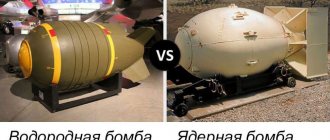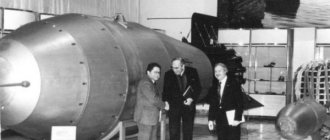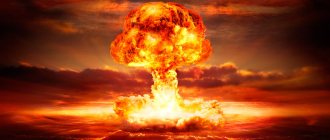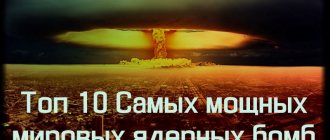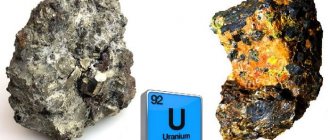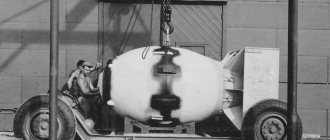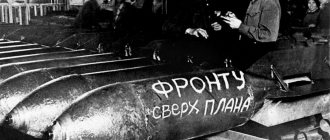Isotopes
From the course of general chemistry, we remember that the matter around us consists of atoms of different “sorts”, and their “sort” determines exactly how they will behave in chemical reactions. Physics adds that this happens due to the fine structure of the atomic nucleus: inside the nucleus there are protons and neutrons that form it - and electrons constantly “rush” around in “orbits”. Protons provide a positive charge to the nucleus, and electrons provide a negative charge, compensating for it, which is why the atom is usually electrically neutral.
Uranus core
From a chemical point of view, the “function” of neutrons comes down to “dilute” the uniformity of nuclei of the same “type” with nuclei with slightly different masses, since only the charge of the nucleus will affect the chemical properties (through the number of electrons, due to which the atom can form chemical bonds with other atoms). From the point of view of physics, neutrons (like protons) participate in the preservation of atomic nuclei due to special and very powerful nuclear forces - otherwise the atomic nucleus would instantly fly apart due to the Coulomb repulsion of like-charged protons. It is neutrons that allow the existence of isotopes: nuclei with identical charges (that is, identical chemical properties), but different in mass.
It is important that it is impossible to create nuclei from protons/neutrons in an arbitrary manner: there are their “magic” combinations (in fact, there is no magic here, physicists have just agreed to call especially energetically favorable ensembles of neutrons/protons that way), which are incredibly stable - but “departing “From them, you can get radioactive nuclei that “fall apart” on their own (the further they are from the “magic” combinations, the more likely they are to decay over time).
Hydrogen bomb vs atomic bomb
A hydrogen bomb and an atomic bomb are both types of nuclear weapons, but one device is very different from the other. In a nutshell, an atomic bomb is a fission device, while a hydrogen bomb uses fission to power a fusion reaction. In other words, an atomic bomb could be used as a detonator for a hydrogen bomb.
Look at the descriptions of the bomb types to understand the differences between them.
ATOMIC BOMB
An atomic bomb or A-bomb is a nuclear weapon that explodes due to the enormous amount of energy released during nuclear fission. For this reason, this type of bomb is also known as a fission bomb. The word “atomic” is not entirely accurate, since fission involves only the nucleus of an atom (its protons and neutrons), and not the entire atom with its electrons.
A substance begins to divide after it reaches a critical mass. This can be achieved in two ways. Either by compressing a non-critical mass of matter using explosives or by shooting one part of a non-critical mass into another. A fissile substance is enriched uranium or plutonium. The amount of energy released from the reaction can vary from a ton to 500 kilotons of TNT explosive equivalent. The bomb also emit radiation, which is a consequence of the division of heavy nuclei into smaller ones.
HYDROGEN BOMB DEFINITION
A hydrogen bomb or H-bomb is a type of nuclear weapon that explodes from the intense energy released by nuclear fusion. The result is energy from the synthesis of hydrogen isotopes - deuterium and tritium.
The action of a hydrogen bomb is based on the use of energy released during the thermonuclear fusion reaction of light nuclei. It is this reaction that takes place in the depths of stars, where, under the influence of ultra-high temperatures and enormous pressure, hydrogen nuclei collide and merge into heavier helium nuclei. During the reaction, part of the mass of hydrogen nuclei is converted into a large amount of energy - thanks to this, stars constantly release huge amounts of energy. Scientists copied this reaction using hydrogen isotopes deuterium and tritium, giving it the name “hydrogen bomb.” Initially, liquid isotopes of hydrogen were used to produce charges, and later lithium-6 deuteride, a solid compound of deuterium and an isotope of lithium, was used.
Lithium-6 deuteride is the main component of the hydrogen bomb, thermonuclear fuel. It already stores deuterium, and the lithium isotope serves as the raw material for the formation of tritium. To start a thermonuclear fusion reaction, it is necessary to create high temperatures and pressures, as well as to separate tritium from lithium-6. The Tsar Bomba, the largest nuclear weapon ever detonated, is a 50 megaton hydrogen bomb.
ATOMIC BOMB VS HYDROGEN BOMB
Both types of nuclear weapons release enormous amounts of energy from a small amount of matter, much of which is released by fission. The hydrogen bomb has potentially higher power and is a more complex device to create.
OTHER TYPES OF NUCLEAR DEVICES
In addition to atomic bombs and hydrogen bombs, there are other types of nuclear weapons:
A neutron bomb is a neutron bomb, just like a hydrogen bomb is a thermonuclear weapon. The explosion of a neutron bomb is relatively small, but a large number of neutrons are released.
While living organisms are killed by this type of bomb, less radioactive fallout occurs and structures are more likely to remain intact.
Salt bomb - Thermonuclear, but with the addition of cobalt, which, under the influence of neutrons, turns into a very radioactive isotope and causes severe contamination of the area. Sufficiently powerful cobalt bombs can infect the entire territory of the Earth; in fact, these weapons have no practical value because their effects are difficult to control and can spread over large areas, making them uninhabitable.
Pure Fusion Bomb - Purely fused nuclear weapon bombs that produce a thermonuclear reaction without the aid of a fission bomb trigger. This type of bomb will not produce significant radioactive fallout.
Electromagnetic Bomb - This bomb is designed to produce a nuclear electromagnetic pulse that can disrupt electronic equipment. A nuclear device triggered in the atmosphere emits a spherical electromagnetic pulse.
The purpose of such weapons is to damage electronics over a large area.
Antimatter Bomb - The bomb releases energy from the annihilation reaction that occurs when matter interacts with antimatter. Such a device was not produced due to problems in synthesizing significant amounts of antimatter.
Share
Nucleosynthesis
A little higher it turned out that according to certain rules it is possible to “construct” atomic nuclei, creating increasingly heavier ones from protons/neutrons. The subtlety is that this process is energetically favorable (that is, it proceeds with the release of energy) only up to a certain limit, after which it is necessary to spend more energy to create increasingly heavier nuclei than is released during their synthesis, and they themselves become very unstable. In nature, this process (nucleosynthesis) occurs in stars, where monstrous pressures and temperatures “compact” the nuclei so tightly that some of them merge, forming heavier ones and releasing energy due to which the star shines.
The conventional “efficiency limit” passes through the synthesis of iron nuclei: the synthesis of heavier nuclei is energy-consuming and iron ultimately “kills” the star, and heavier nuclei are formed either in trace quantities due to the capture of protons/neutrons, or en masse at the time of the death of the star in the form a catastrophic supernova explosion, when the fluxes of radiation reach truly monstrous values (at the moment of the explosion, a typical supernova emits as much light energy as our Sun over about a billion years of its existence!)
Whose button is bigger?
“The nuclear button is always on my desk,” North Korean leader Kim Jong Un said during his New Year’s address. In response, US President Donald Trump wrote on his favorite microblog on Twitter: “Let someone from an impoverished and starved regime inform him that I also have a nuclear button, but it is much larger and much more powerful than his, and my button works "
Trump and Kim are a threat to the world and a holiday for cartoonists
Nuclear/thermonuclear reactions
So, now we can give the necessary definitions:
nuclear fusion in English ) is a type of nuclear reaction in which lighter atomic nuclei, due to the energy of their kinetic motion (heat), merge into heavier ones.
Thermonuclear reaction
nuclear fission in English ) is a type of nuclear reaction where the nuclei of atoms spontaneously or under the influence of particles “from the outside” disintegrate into fragments (usually two or three lighter particles or nuclei).
Nuclear fission reaction
In principle, in both types of reactions energy is released: in the first case, due to the direct energetic benefit of the process, and in the second, the energy that was spent during the “death” of the star on the emergence of atoms heavier than iron is released.
Neutron bomb
After the appearance of the first atomic bomb, scientists in the USSR and the USA began to think about weapons that would not cause such great destruction and contamination of enemy territories, but would have a targeted effect on the human body. The idea arose to create a neutron bomb
.
The principle of operation is the interaction of a neutron flux with living flesh and military equipment
. The more radioactive isotopes produced instantly destroy a person, and tanks, transporters and other weapons become sources of strong radiation for a short time.
A neutron bomb explodes at a distance of 200 meters to ground level, and is especially effective during an enemy tank attack. The armor of military equipment, 250 mm thick, is capable of reducing the effects of a nuclear bomb several times, but is powerless against the gamma radiation of a neutron bomb. Let's consider the effects of a neutron projectile with a power of up to 1 kiloton on a tank crew:
| Explosion radius | 400 meters | 400-800 meters | 800-1400 meters |
| Detrimental effects on the crew of the equipment | There is an immediate loss of combat effectiveness of the crew. Death within 24 hours. | Personnel failure - 2..3 minutes, death - 5-6 days. | Loss of combat effectiveness - 1 hour, death occurs within two weeks. |
As you understand, the difference between a hydrogen bomb and an atomic bomb is enormous. The difference in the nuclear fission reaction between these charges makes a hydrogen bomb hundreds of times more destructive than an atomic one.
.
When using a 1 megaton thermonuclear bomb, everything within a radius of 10 kilometers will be destroyed. Not only buildings and equipment will suffer, but also all living things.
The heads of nuclear countries should remember this, and use the “nuclear” threat solely as a deterrent tool, and not as an offensive weapon.
The essential difference between nuclear and thermonuclear bombs
A nuclear (atomic) bomb is usually called an explosive device where the main share of the energy released during the explosion is released due to the nuclear fission reaction, and a hydrogen (thermonuclear) bomb is one where the main share of the energy is produced through a thermonuclear fusion reaction. An atomic bomb is a synonym for a nuclear bomb, a hydrogen bomb is a synonym for a thermonuclear bomb.
Nuclear bomb
Strictly speaking, all currently existing hydrogen bombs are “along the way” nuclear, since the “igniting match” in them is the “ignition” nuclear charge, which for a short moment initiates approximately the same conditions as inside a star - so that thermonuclear reactions can “start” for that moment " A hydrogen bomb has much greater and more destructive power than a nuclear bomb. Hydrogen bombs are not in service in any country in the world.
H-bomb
ScienceComment
Nuclear physics, but an atomic reactor. Nuclear fuel, but a nuclear explosion. Where is the mistake here? What's the catch?
Russian language dictionaries will authoritatively tell you that there is no catch, and the words nuclear and atomic in general are synonyms. However, life, as we know, is richer. And the life of nuclear scientists and physicists is also enriched with its own meanings and traditions.
Let's start with the fact that the nucleus and the atom are, strictly speaking, generally different things, or rather, one part of the other. Actually, this is why the science of atomic physics exists, and in the neighboring block nuclear physics is thriving and thriving - the science is already different.
Physicists will tell you that all processes in which the energy of the nucleus plays the most important role are called nuclear. However, here the Russian language turns out to be richer, in which fixed expressions take root so easily.
Therefore, you just have to take it for granted and remember that:
1. An icebreaker and a submarine in written and spoken language are always nuclear (this has historically happened, although from the point of view of common sense they are, of course, nuclear)
Nuclear icebreaker "Yamal"
2. The branch, industry, power plants, construction sites, cities are also nuclear, as, by the way, is the famous nuclear project (it is written without quotes and with a small letter, which is also worth remembering)
3. Nuclear always: fuel and everything connected with it - first of all, the nuclear fuel cycle (NFC), safety, medicine, materials, accidents, waste, heritage, etc.
By the way! Nuclear fuel cannot be called nuclear fuel, even if your soul is sick of the abundance of repetitions in the text, and your inquisitive mind craves epithets. Reactors use nuclear fuel, but not nuclear or atomic fuel: it does not burn there, but works.
4. Both definitions are acceptable – atomic and nuclear when it comes to energy, energy, reactors, and industrial engineering. Atomic and nuclear energy are the same thing, just as a reactor will not change its properties - call it nuclear or atomic.
By the way! In practice, nuclear is more often used when talking about generation; the word “nuclear” shifts the conversation towards physical processes and technologies. Thus, historically, industry employees are nuclear scientists, and physicists are nuclear scientists.
5. Weapons - nuclear. Our shield is nuclear, and our defense complex is nuclear. However, there were some nuances here too: the first bombs were atomic, like the bombings of Hiroshima and Nagasaki, and therefore the Soviet project was also atomic (we have already talked about it).
The first Soviet hydrogen bomb, RDS-6s
The word “nuclear” became the main one in nuclear weapons in the early 1950s, when hydrogen (thermonuclear) bombs appeared. Therefore, if we are talking about time periods after the mid-1950s, it is correct to use the definition nuclear: test, strike, weapon, warhead, weapons complex. For explosions and tests that took place before the early 1950s, both options are acceptable.
6. Powers – nuclear. These are the ones who have nuclear weapons. They are also called the “Nuclear Club”. Can you list all nine right away without Google?
7. Technologies that relate to the energy of the nucleus of an atom are, of course, nuclear, and in fact the battery of the future is nuclear. However, if we are talking about the work of the industry as a whole, using the word “nuclear” is not forbidden.
For example: “Nuclear” technologies are actively used today in many industries.
Confused? God be with them! Say “nuclear technology” - you can’t go wrong!
8. And, of course, we cannot escape journalistic clichés: , etc. Just be careful with it - an insatiable craving for cliches can ruin any speech - be it written or oral.
Tweet
Share
Share
Cool
Send
